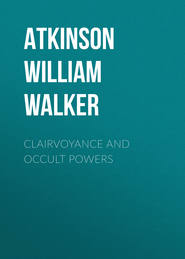По всем вопросам обращайтесь на: info@litportal.ru
(©) 2003-2024.
✖
The Art of Logical Thinking; Or, The Laws of Reasoning
Настройки чтения
Размер шрифта
Высота строк
Поля
1. All universals distribute the subject.
2. All particulars do not distribute the subject.
3. All negatives distribute the predicate.
4. All affirmatives do not distribute the predicate.
The above rules are based upon logical reasoning. The reason for the first two rules is quite obvious, for when the subject is universal, it follows that the whole subject is involved; when the subject is particular it follows that only a part of the subject is involved. In the case of the third rule, it will be seen that in every negative proposition the whole of the predicate must be denied the subject, as for instance, when we say: "Some animals are not horses," the whole class of horses is cut off from the subject, and is thus distributed. In the case of the fourth rule, we may readily see that in the affirmative proposition the whole of the predicate is not denied the subject, as for instance, when we say that: "Horses are animals," we do not mean that horses are all the animals, but that they are merely a part or portion of the class animal – therefore, the predicate, animals, is not distributed.
In addition to the forms of Propositions given there is another class of Propositions known as Definitive or Substitutive Propositions, in which the Subject and the Predicate are exactly alike in extent and rank. For instance, in the proposition, "A triangle is a polygon of three sides" the two terms are interchangeable; that is, may be substituted for each other. Hence the term "substitutive." The term "definitive" arises from the fact that the respective terms of this kind of a proposition necessarily define each other. All logical definitions are expressed in this last mentioned form of proposition, for in such cases the subject and the predicate are precisely equal to each other.
CHAPTER X.
IMMEDIATE REASONING
In the process of Judgment we must compare two concepts and ascertain their agreement of disagreement. In the process of Reasoning we follow a similar method and compare two judgments, the result of such comparison being the deduction of a third judgment.
The simplest form of reasoning is that known as Immediate Reasoning, by which is meant the deduction of one proposition from another which implies it. Some have defined it as: "reasoning without a middle term." In this form of reasoning only one proposition is required for the premise, and from that premise the conclusion is deduced directly and without the necessity of comparison with any other term of proposition.
The two principal methods employed in this form of Reasoning are; (1) Opposition; (2) Conversion.
Opposition exists between propositions having the same subject and predicate, but differing in quality or quantity, or both. The Laws of Opposition are as follows:
I. (1) If the universal is true, the particular is true. (2) If the particular is false, the universal is false. (3) If the universal is false, nothing follows. (4) If the particular is true, nothing follows.
II. (1) If one of two contraries is true, the other is false. (2) If one of two contraries is false, nothing can be inferred. (3) Contraries are never both true, but both may be false.
III. (1) If one of two sub-contraries is false, the other is true. (2) If one of two sub-contraries is true, nothing can be inferred concerning the other. (3) Sub-contraries can never be both false, but both may be true.
IV. (1) If one of two contradictories is true, the other is false. (2) If one of two contradictories is false, the other is true. (3) Contradictories can never be both true or both false, but always one is true and the other is false.
In order to comprehend the above laws, the student should familiarize himself with the following arrangement, adopted by logicians as a convenience:
Examples of the above: Universal Affirmative (A): "All men are mortal;" Universal Negative (E): "No man is mortal;" Particular Affirmative (I): "Some men are mortal;" Particular Negative (O): "Some men are not mortal."
The following examples of abstract propositions are often used by logicians as tending toward a clearer conception than examples such as given above:
(A) "All A is B."
(I) "Some A is B."
(E) "No A is B."
(O) "Some A is not B."
These four forms of propositions bear certain logical relations to each other, as follows:
A and E are styled contraries. I and O are sub-contraries; A and I and also E and O are called subalterns; A and O and also I and E are styled contradictories.
A close study of these relations, and the symbols expressing them, is necessary for a clear comprehension of the Laws of Opposition stated a little further back, as well as the principles of Conversion which we shall mention a little further on. The following chart, called the Square of Opposition, is also employed by logicians to illustrate the relations between the four classes of propositions:
Conversion is the process of immediate reasoning by which we infer from a given proposition another proposition having the predicate of the original for its subject and the subject of the original for its predicate; or stated in a few words: Conversion is the transposition of the subject and predicate of a proposition. As Brooks states it: "Propositions or judgments are converted when the subject and predicate change places in such a manner that the resulting judgment is an inference from the given judgment." The new proposition, resulting from the operation or Conversion, is called the Converse; the original proposition is called the Convertend.
The Law of Conversion is that: "No term must be distributed in the Converse that is not distributed in the Convertend." This arises from the obvious fact that nothing should be affirmed in the derived proposition than there is in the original proposition.
There are three kinds of Conversion; viz: (1) Simple Conversion; (2) Conversion by Limitation; (3) Conversion by Contraposition.
In Simple Conversion there is no change in either quality or quantity. In Conversion by Limitation the quality is changed from universal to particular. In Conversion by Negation the quality is changed but not the quantity. Referring to the classification tables and symbols given in the preceding pages of this chapter, we may now proceed to consider the application of these methods of Conversion to each of the four kinds of propositions; as follows:
The Universal Affirmative (symbol A) proposition is converted by Limitation, or by a change of quality from universal to particular. The predicate not being "distributed" in the convertend, we must not distribute it in the converse by saying "all." Thus in this case we must convert the proposition, "all men are mortal" (A), into "some mortals are men" (I).
The Universal Negative (symbol E) is converted by Simple Conversion, in which there is no change in either quality or quantity. For since both terms of "E" are distributed, they may both be distributed in the converse without violating the law of conversion. Thus "No man is mortal" is converted into: "No mortals are men." "E" is converted into "E."
The Particular Affirmative (symbol I) is also converted by Simple Conversion in which there is no change in either quality or quantity. For since neither term is distributed in "I," neither term may be distributed in the converse, and the latter must remain "I." For instance; the proposition: "Some men are mortal" is converted into the proposition, "Some mortals are men."
The Particular Negative (symbol O) is converted by Conversion by Negation, in which the quality is changed but not the quantity. Thus in converting the proposition: "Some men are not mortal," we must not say "some mortals are not men," for in so doing we would distribute men in the predicate, where it is not distributed in the convertend. Avoiding this, we transfer the negative particle from the copula to the predicate so that the convertend becomes "I" which is converted by Simple Conversion. Thus we transfer "Some men are not mortal" into "Some men are not-mortal" from which we easily convert (by simple Conversion) the proposition: "Some not-mortals are men."
It will be well for students, at this point, to consider the three following Fundamental Laws of Thought as laid down by the authorities, which are as follows:
The Law of Identity, which states that: "The same quality or thing is always the same quality or thing, no matter how different the conditions in which it occurs."
The Law of Contradiction, which states that: "No thing can at the same time and place both be and not be."
The Law of Excluded Middle, which states that: "Everything must either be or not be; there is no other alternative or middle course."
Of these laws, Prof. Jevons, a noted authority, says: "Students are seldom able to see at first their full meaning and importance. All arguments may be explained when these self-evident laws are granted; and it is not too much to say that the whole of logic will be plain to those who will constantly use these laws as the key."
CHAPTER XI.
INDUCTIVE REASONING
Inductive Reasoning, as we have said, is the process of discovering general truth from particular truths, or inferring general laws from particular facts. Thus, from the experience of the individual and the race regarding the particular truth that each and every man under observation has been observed to die sooner or later, it is inferred that all men die, and hence, the induction of the general truth that "All men must die." Or, as from experience we know that the various kinds of metals expand when subjected to heat, we infer that all metals are subject to this law, and that consequently we may arrive by inductive reasoning at the conclusion that: "All metals expand when subjected to heat." It will be noticed that the conclusion arrived at in this way by Inductive Reasoning forms the fundamental premise in the process of Deductive Reasoning. As we have seen elsewhere, the two processes, Inductive and Deductive Reasoning, respectively are interdependent – resting upon one another.
Jevons says of Inductive Reasoning: "In Deductive Reasoning we inquire how we may gather the truth contained in some propositions called Premises, and put into another proposition called the Conclusion. We have not yet undertaken to find out how we can learn what propositions really are true, but only what propositions are true when other ones are true. All the acts of reasoning yet considered would be called deductive because we deduce, or lead down the truth from premises to conclusion. It is an exceedingly important thing to understand deductive inference correctly, but it might seem to be still more important to understand inductive inference, by which we gather the truth of general propositions from facts observed as happening in the world around us." Halleck says: "Man has to find out through his own experience, or that of others, the major premises from which he argues or draws his conclusions. By induction we examine what seems to us a sufficient number of individual cases. We then conclude that the rest of these cases, which we have not examined, will obey the same general law… Only after general laws have been laid down, after objects have been classified, after major premises have been formed, can deduction be employed."
Strange as may now appear, it is a fact that until a comparatively recent period in the history of man, it was held by philosophers that the only way to arrive at all knowledge was by means of Deductive Reasoning, by the use of the Syllogism. The influence of Aristotle was great and men preferred to pursue artificial and complicated methods of Deductive Reasoning, rather than to reach the truth by obtaining the facts from Nature herself, at first hand, and then inferring general principle from the facts so gathered. The rise of modern scientific methods of reasoning, along the lines of Inductive Inference, dates from about 1225-1300. Roger Bacon was one of the first to teach that we must arrive at scientific truth by a process of observation and experimentation on the natural objects to be found on all sides. He made many discoveries by following this process. He was ably seconded by Galileo who lived some three hundred years later, and who also taught that many great general truths might be gained by careful observation and intelligent inference. Lord Francis Bacon, who lived about the same time as Galileo, presented in his Novum Organum many excellent observations and facts regarding the process of Inductive Reasoning and scientific thought. As Jevons says: "Inductive logic inquires by what manner of reasoning we can gather the laws of nature from the facts and events observed. Such reasoning is called induction, or inductive inquiry, and, as it has actually been practiced by all the great discoverers in science, it consists in four steps."
The Four Steps in Inductive Reasoning, as stated by Jevons, are as follows:
First Step.– Preliminary observation.
Second Step.– The making of hypotheses.
Third Step.– Deductive reasoning.
Fourth Step.– Verification.
It will be seen that the process of Inductive Reasoning is essentially a synthetic process, because it operates in the direction of combining and uniting particular facts or truths into general truths or laws which comprehend, embrace and include them all. As Brooks says: "The particular facts are united by the mind into the general law; the general law embraces the particular facts and binds them together into a unity of principle and thought. Induction is thus a process of thought from the parts to the whole – a synthetic process." It will also be seen that the process of Inductive Reasoning is essentially an ascending process, because it ascends from particular facts to general laws; particular truths to universal truths; from the lower to the higher, the narrower to the broader, the smaller to the greater.











